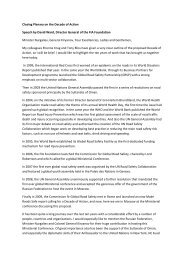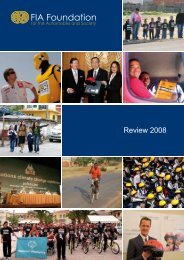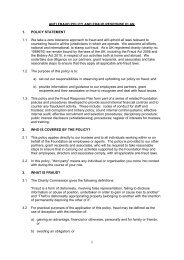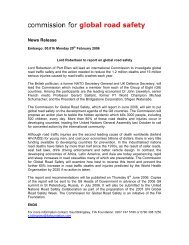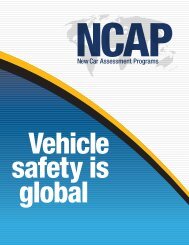5. Оценка программыСсылки1. Thompson NJ, McClintock HO. Demonstrating your program’s worth: a primer on evaluation forprograms to prevent unintentional injury. Atlanta, Centers for Disease Control and Prevention,National Center for Injury Prevention and Control, 1998.2. Rossi PH et al. Evaluation: a systematic approach. California, Sage Publications, 2004.3. THINK! Always wear a seat belt: rear seat belt campaign. Think! Road Safety Campaign, UnitedKingdom Department for Transport, 2003 (http://www.thinkroadsafety.gov.uk/campaigns/seatbelts/rear.htm, accessed 12 November 2008).4. Zaza S et al. Methods for conducting systematic reviews of the evidence of effectiveness andeconomic efficiency of interventions to reduce injuries to motor vehicle occupants. AmericanJournal of Preventive Medicine, 2001, 21(4S):23–30.5. Stevenson M et al. Reducing the burden of road traffic injury: translating high-income countryinterventions to middle- and low-income countries. Injury Prevention, in press 2008.6. Thompson NJ. Study methods for understanding injury behavior. In: Gielen A, Sleet DA,DiClemente R, eds. Injury and violence prevention: behavioral science theories, methods andapplications. San Francisco, Jossey-Bass, 2006.7. Britten N. Qualitative research: qualitative interviews in medical research. British MedicalJournal, 1995, 311:251–253.8. Kitzinger J. Qualitative research: introducing focus groups. British Medical Journal, 1995,311:299–302.9. Blantari J et al. An evaluation of the effectiveness of televised road safety messages in Ghana.International Journal of Injury Control and Safety Promotion, 2005, 12:23–29.10. Goodson J, Buller C, Goodson W. Prenatal child safety education. Obstetrics and Gynaecology,1985, 65:312–315.11. Dowswell T, Towner E. Social deprivation and the prevention of unintentional injury inchildhood: a systematic review. Health Education Research, 2002, 17:221–237.12. Cohn LD et al. A program to increase seat belt use along the Texas-Mexico border. AmericanJournal of Public Health, 2002, 12:1918–1920.13. Seat belts public education campaign. Queensland Transport, 2004 (http://www.roadsafety. qld.gov.au/qt/LTASinfo.nsf/ReferenceLookup/SeatbeltsPubEd.pdf/$file/SeatbeltsPubEd.pdf,accessed 12 November 2008).14. Woodward M. Epidemiology: study design and data analysis, 2nd ed. Boca Raton, Chapman andHall CRC, 2005.15. Rothman KJ, Greenland S. Modern epidemiology, 2nd ed. Hagerstown, Maryland, Lippincott-Raven, 1998.16. Towner E et al. What works in preventing unintentional injuries in children and adolescents? Anupdated systematic review. London, Health Development Agency, 2001.17. Grossman G, Garcia D. Effectiveness of health promotion programs to increase motor vehicleoccupant restraint use among young children. American Journal of Preventive Medicine, 1999,16(IS):12–22.18. Di Guiseppi C, Roberts I. Individual-level injury prevention strategies in the clinical setting.Future Child, 2000, 10(1):53–82.19. Dinh-Zarr T et al. Reviews of evidence regarding interventions to increase the use of safety belts.American Journal of Preventive Medicine, 2001, 21(4S):48–65.186
Ремни безопасности и детские удерживающие устройства: руководство по безопасности дорожного движения для руководителей и специалистов20. Drummond MF et al. Methods for the economic evaluation of health care programmes. Oxford,Oxford University Press, 1997.21. Tan-Torres T et al, eds. WHO guide to cost-effectiveness analysis. Geneva, World HealthOrganization, 2003.22. Miller TR. The effectiveness review trials of Hercules and some economic estimates for thestables. American Journal of Preventive Medicine, 2001, 21(4S):9–12.23. Elvik R, Vaa T, eds. The handbook of road safety measures. Elsevier, 2004.24. Kerry SM, Bland JM. Statistics notes: sample size in cluster randomisation. British MedicalJournal, 1998, 316:549.25. Sogolow E, Sleet DA, Saul J. Dissemination, implementation and widespread use of injuryprevention interventions. In: Doll LS et al., eds. Handbook of injury and violence prevention. NewYork, Springer, 2007.5. Оценка программы187
- Page 1:
Ремнибезопасности
- Page 4 and 5:
Ремни безопасности
- Page 6 and 7:
Содержание1.4. Эффек
- Page 9 and 10:
Ремни безопасности
- Page 12:
Предисловиерезолю
- Page 15 and 16:
Ремни безопасности
- Page 17:
вВведение
- Page 20 and 21:
Введениестран. К ни
- Page 22 and 23:
ВведениеИстория со
- Page 24 and 25:
Введениеситуации,
- Page 26 and 27:
Введениемероприят
- Page 28 and 29:
ВведениеРаспростр
- Page 30 and 31:
11.1 Смертельные слу
- Page 32 and 33:
1. Необходимость в р
- Page 34 and 35:
1. Необходимость в р
- Page 36 and 37:
1. Необходимость в р
- Page 38 and 39:
1. Необходимость в р
- Page 40 and 41:
1. Необходимость в р
- Page 42 and 43:
1. Необходимость в р
- Page 44 and 45:
1. Необходимость в р
- Page 46 and 47:
1. Необходимость в р
- Page 48 and 49:
1. Необходимость в р
- Page 50 and 51:
1. Необходимость в р
- Page 52 and 53:
1. Необходимость в р
- Page 54 and 55:
1. Необходимость в р
- Page 56 and 57:
1. Необходимость в р
- Page 58 and 59:
301. Необходимость в
- Page 60 and 61:
22.1 Необходимость о
- Page 62 and 63:
2. Методы оценки сит
- Page 64 and 65:
2. Методы оценки сит
- Page 66 and 67:
2. Методы оценки сит
- Page 68 and 69:
2. Методы оценки сит
- Page 70 and 71:
2. Методы оценки сит
- Page 72 and 73:
2. Методы оценки сит
- Page 74 and 75:
2. Методы оценки сит
- Page 76 and 77:
2. Методы оценки сит
- Page 78 and 79:
2. Методы оценки сит
- Page 80 and 81:
2. Методы оценки сит
- Page 82 and 83:
2. Методы оценки сит
- Page 84 and 85:
2. Методы оценки сит
- Page 86 and 87:
2. Методы оценки сит
- Page 88 and 89:
2. Методы оценки сит
- Page 90 and 91:
Таб2. Методы оценки
- Page 92 and 93:
2. Методы оценки сит
- Page 95 and 96:
3Планирование иосу
- Page 97 and 98:
Ремни безопасности
- Page 99 and 100:
Ремни безопасности
- Page 101 and 102:
Ремни безопасности
- Page 103 and 104:
Ремни безопасности
- Page 105 and 106:
Ремни безопасности
- Page 107 and 108:
Ремни безопасности
- Page 109 and 110:
Ремни безопасности
- Page 111 and 112:
Ремни безопасности
- Page 113 and 114:
Ремни безопасности
- Page 115 and 116:
Ремни безопасности
- Page 117 and 118:
4Разработка и реали
- Page 119 and 120:
Ремни безопасности
- Page 121 and 122:
Ремни безопасности
- Page 123 and 124:
Ремни безопасности
- Page 125 and 126:
Ремни безопасности
- Page 127 and 128:
Ремни безопасности
- Page 129 and 130:
Ремни безопасности
- Page 131 and 132:
Ремни безопасности
- Page 133 and 134:
Ремни безопасности
- Page 135 and 136:
Ремни безопасности
- Page 137 and 138:
Ремни безопасности
- Page 139 and 140:
Ремни безопасности
- Page 141 and 142:
Ремни безопасности
- Page 143 and 144:
Ремни безопасности
- Page 145 and 146:
Ремни безопасности
- Page 147 and 148:
Ремни безопасности
- Page 149 and 150:
Ремни безопасности
- Page 151 and 152:
Ремни безопасности
- Page 153 and 154:
Ремни безопасности
- Page 155 and 156:
Ремни безопасности
- Page 157 and 158:
Ремни безопасности
- Page 159 and 160:
Ремни безопасности
- Page 161 and 162:
Ремни безопасности
- Page 163 and 164: Ремни безопасности
- Page 165 and 166: Ремни безопасности
- Page 167 and 168: Ремни безопасности
- Page 169 and 170: Ремни безопасности
- Page 171 and 172: Ремни безопасности
- Page 173 and 174: Ремни безопасности
- Page 175 and 176: Ремни безопасности
- Page 177 and 178: Ремни безопасности
- Page 179 and 180: Ремни безопасности
- Page 181 and 182: Ремни безопасности
- Page 183 and 184: Ремни безопасности
- Page 185 and 186: Ремни безопасности
- Page 187 and 188: Ремни безопасности
- Page 189 and 190: Ремни безопасности
- Page 191 and 192: Ремни безопасности
- Page 193 and 194: 5Оценка программы
- Page 195 and 196: Ремни безопасности
- Page 197 and 198: Ремни безопасности
- Page 199 and 200: Ремни безопасности
- Page 201 and 202: Ремни безопасности
- Page 203 and 204: Ремни безопасности
- Page 205 and 206: Ремни безопасности
- Page 207 and 208: Ремни безопасности
- Page 209 and 210: Ремни безопасности
- Page 211 and 212: Ремни безопасности
- Page 213: Ремни безопасности
- Page 217 and 218: ППриложения
- Page 219 and 220: Ремни безопасности
- Page 221 and 222: Ремни безопасности
- Page 223 and 224: Ремни безопасности
- Page 225 and 226: Ремни безопасности
- Page 227 and 228: Ремни безопасности
- Page 229 and 230: Ремни безопасности
- Page 231 and 232: Ремни безопасности
- Page 233 and 234: Ремни безопасности
- Page 235 and 236: Ремни безопасности
- Page 237 and 238: 2. Заданные области
- Page 239 and 240: Ремни безопасности
- Page 241 and 242: Ремни безопасности
- Page 243 and 244: Ремни безопасности
- Page 245 and 246: Ремни безопасности
- Page 247 and 248: Ремни безопасности
- Page 249 and 250: Ремни безопасности
- Page 251 and 252: Ремни безопасности
- Page 253 and 254: Ремни безопасности
- Page 255 and 256: Ремни безопасности
- Page 257 and 258: Ремни безопасности
- Page 259 and 260: Ремни безопасности
- Page 261: Ремни безопасности




